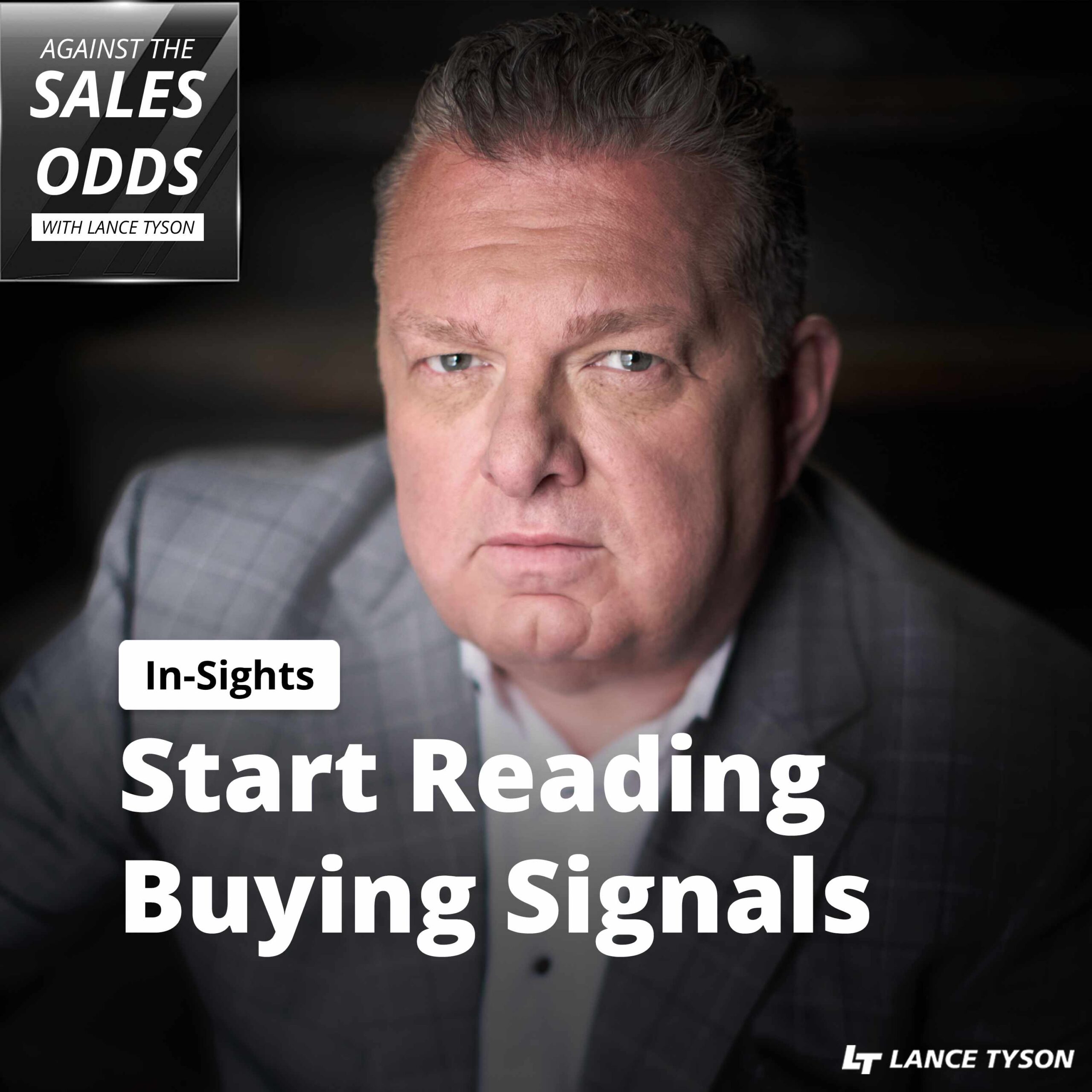In this In-Sights episode of Against the Sales Odds, Lance breaks down one of the most common traps in sales — buying signals. Too often, salespeople jump in with what they think instead of paying attention to what the buyer is signaling. Lance explains how to identify real buying cues, when to speak, and when to step back — so every conversation moves you closer to a close.
👉 Tune in now and rediscover why the first steps in sales are the most powerful.
Check out Tyson Group’s Open Enrollment Programs: https://www.tysongroup.com/openenrollment
Check out Lance’s Bestseller Books:
The Human Sales Factor – https://tysongroup.com/books#thehumansalesfactor
Selling is an Away Game – https://tysongroup.com/books#sellingisanawaygame
Download our playbooks: https://www.tysongroup.com/sales-playbooks
Schedule a call with one of Tyson Group’s member: https://bit.ly/41YJW7K
Subscribe to our Newsletter: https://tysongroup.com/#weeklynewsletter
Follow Lance across Social Media:
LinkedIn – https://www.linkedin.com/in/lancetyson/
Instagram – https://www.instagram.com/lance_tyson_1/
Love the show? Subscribe, rate, review, and share! https://www.tysongroup.com/podcast
—
Listen to the podcast here
Start Reading Buying Signals
It’s Not About Selling Harder. It’s About Listening Smarter
First of all, I wanted to talk about the power of personal brands. What’s that personal brand for you? It’s a part of the sales process of the employee. I would say the other thing. When you focus on two, their knowledge is power, having the opinions baked into how you sell. The last thing I want to say about my opinion even stronger is, it’s important to write this down and I’ll give you an example of this, too. Are you giving them a strong opinion? Are you giving them your opinion?
Why Strong Opinions Are Needed In Sales
I was watching a bunch of sales presentations. I was talking about Buffalo. There’s a sales guy and his name is Dustin Campbell. Dustin’s had a long trip in his sales career and he did a demo. He worked for the bills. He just moved up. He’s worked for the Cleveland Cavaliers and for the Miami Dolphins. He’s worked all over the place and we had been doing about 40 pitchers in a row. They were pitching some hospitality. I said, “Dustin, why don’t you get up and pitch?” He did a mock pitch and it’s not a role play. It was like him just talking like he was talking to a buyer. I’m not into role playing things because it’s not the best way to train adults.
When he made his recommendation, he basically said something like this, “Based off of what you’re saying, I strongly recommend this product because of why.” Everybody else had given all the options and almost confused it. Dustin gave the advice. I think knowledge is power and you give people opinions, your strong opinions will last. That’s another thing I’m seeing changes in sales. You should get there because that’s what people are looking for from you, because that’s the trusted advisor.
Knowledge is power. Giving people your strong opinions is becoming a big thing in sales.
How To Start Reading Buying Signals
When I go to Tom Simon about the investment. He’s my CPA, but he also does a lot of our family financial planning. He’ll say, “I recommend this to the portfolio because of X, Y, and Z.” He’ll make the recommendation and I appreciate that because I don’t have the time to go study everything. I want his recommendation. In your spot, you should look at that. Let’s look at how you communicate now and when you’re giving some of these opinions.
We’re still at a high level. I don’t know if you’ve ever thought about this. When you’re communicating, you start off at 9:00. You’re sending a message to somebody and you’re going back and forth in a meeting. As you’re sending the message, your message goes through your filter. Your filters are your assumptions, history, and biography. Anything that has to do with it, you communicate from your filter. The message is then received through somebody else’s filter. That’s their assumptions and their background.
By the time you send a message, especially in selling. For instance, let’s say, I’m on my worst days yet. They are right there smackdown. Let’s say I’m walking Daisy through. I’m walking her through like a center. I in different spots ask, “What’s your thoughts on this? What’s your opinion on this?” As I’m presenting, I’m constantly asking her for feedback on different things. I’m cupcake testing all the way through. Now, here’s what’s important for all of you. Why don’t you think about this first second? What’s important is that you can buy signals. I’m pitching Daisy and I’m sitting across from her. I’m like, “What’s this mean?”
This could be a cold. This could mean I need a shave. You love watching the pundits up there when somebody likes a newscaster and they’ll go, “It was clearly up the stand. I was thinking X, Y, and Z based on their posture and everything else.” You’re like, “Shut up. You have no freaking clue what they were thinking.” That’s what I’m arguing against. You got to know what a buying signal is. A buying signal is anything a buyer says or does or doesn’t say or doesn’t do that indicates interest.
It can be an action or a statement, or they don’t say or don’t do that to indicate interest. You know you’ve given some pitches and they didn’t ask any questions. You’re like, “I think I got them.” Jennifer calls you up and she asks, “How’s the appointment?” You go, “It was awesome.” Are you going to get it? Absolutely. That’s always the answer, isn’t it? You have an appointment. You’re going to get the sale. I got it. Why didn’t you get it yet? Not a good time but I was going to get it. Everything’s great.

We have a tendency when we sell to look when we pitch. We have a tendency to look at all indicators that cause or contribute to our bias. It’s called contribution bias. When you go buy a new product or service. Say you’re going to get a new iPhone or you’re going to buy a new suit or new bag or whatever you’re buying. You look at all the factors that contribute to your bias. There’s all the reasons I should have this. We pitch a lot of times.
We look at our bias. They’re going to buy more because of X. They all have to be tested. You can’t just assume you know what it means. Remember, if we go back to the first principle, you haven’t sold them before. It doesn’t matter what your experience is if you haven’t sold to them. Your experience guides you but it doesn’t always make a decision for you. Everything has to be better. We have tested it. That being a trial close. What are your thoughts about this? What’s your opinion here?
How To Watch Out For Warning Signals
People can’t value what they can’t compare and contrast. What do you like about this? What do you hate about it? What do you hate about it? What do you like about it? You’d ask all these questions because you have to form an opinion to close the sale. You have to read buy warning signals and the only way to read buy warning signals is to ask. That’s the remedy. What’s a warning signal? A warning signal is just the opposite. It’s anything a buyer says or does or doesn’t say or doesn’t do that indicates disinterest. It’s just the opposite.
How do you identify a warning signal? The same remedy. Right back to the cupcake. Right back to the toothpick and the cake. What’s an objection? Objection is anything the buyer says or does or doesn’t say or doesn’t do. It is a hesitation to move forward with the sale, but it’s just bigger than buying a warning signal.
Important Links
- Lance Tyson on LinkedIn
- Lance Tyson on Instagram
- Lance Tyson on X
- Check out Tyson Group’s Open Enrollment Programs
- The Human Sales Factor
- Selling is an Away Game
- Download our Playbooks
- Schedule a call with one of Tyson Group’s Member
- Subscribe to our Newsletter
- Against The Sales Odds




